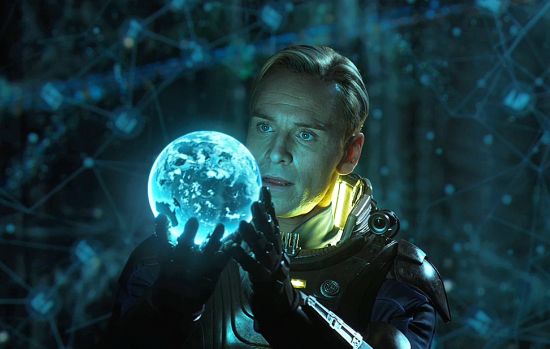Typically, this space is meant for book reviews but after seeing Prometheus last night I feel compelled to say a few things about the new Alien story, written mostly by Damon Lindelof. This discussion will be SPOILER-rific, so maybe go see the movie first, then come back and read.
LAST WARNING, SPOILERS AHEAD.
First of all, I need to correct some things you may have read in Lisa Schwarzbaum’s review in Entertainment Weekly. As a writer, myself (though still very green and naive), I get pretty upset when a well-read critic mis-understands the finer points of one of my stories. If you read Lisa’s review, you come away believing that Prometheus doesn’t have the balls to back a specific religion as the protector of humanity. She also weirdly refers to the aliens as “directors” instead of “engineers” but I digress.
Prometheus clearly endorses Christianity. You kind of have to be blind to miss this. The lead, Elizabeth Shaw, carries a cross (literally) through the film. The spaceship lands on Christmas Day. There’s even a scene where robot David washes the feet of his creator. If you went to Sunday school, you couldn’t miss this.
Why is it important? Because Christianity might be the whole point of the bigger story that Lindelof and Ridley Scott have set up, here.
We learn early on in the film that the “Space Jockeys,” the very tall super humans who seeded life on Planet Earth (through *ahem* messianic self-sacrifice) all died out around “2,000 years ago” when there was some discussion about destroying the humans they had created. Anything important supposedly happen on Earth about 2,000 years ago? Oh right, people started worshiping Jesus as the “son of God.” Imagine if the robots we eventually create suddenly began to believe they were created by this superior being who promised them eternal life? We might get mad but more probably, we would think something was wrong with their circuitry. A glitch. And we’d want to fix them. Perhaps by scrapping their model and starting over.
If you miss the Christianity connection, which many reviewers did, you miss the whole subtext of what’s going on between the Space Jockeys and humans. And humans and robots.
Having some time to think about it, here’s what I think happened with the Space Jockeys. Their leader heard about this Jesus thing and freaked the eff out. Decided it was time to wipe humanity out with those weaponized alien vases. But one Space Jockey had second thoughts. Let’s see what becomes of this Jesus thing, it thought. And so it opened up some canisters, releasing aliens on its own kind, before sealing itself in the cryogenic pod. It wanted to wait until humans came for it, to see if they had evolved into the graceful and kind race that Christianity promised.
Except, when it’s finally awaked by the humans, what is the first thing it sees? A fight. The humans have come this far but are still fighting with each other. The experiment was a failure, after all. The right decision all along was to wipe out humanity.
A bummer, sure. But one that makes a lot more sense, in context.
